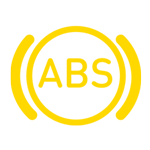It’s important to know what car dashboard warning lights mean because you might be able to avoid a car breakdown or full-on failure.
This guide will give you the know how you need to understand what the different yellow and red warning lights on your dashboard mean, why they come on, how urgent the problem is and what you should do when you see them.
The car warning lights on your dashboard follow a traffic light colour system:
- Green: the system is working correctly or is currently in use
- Yellow: something is not working correctly – take extra care and check it out as soon as possible
- Red: there is a serious, and potentially dangerous problem – stop driving as soon as it is safe to do so
Don’t see the light you need? Check out our manufacturer-specific car warning lights pages:
Brake warning light
Also known as the brake system warning light, parking brake warning light or brake fluid warning light.
If this red light remains on after you fully release the parking brake, or comes on when you’re driving, it may indicate that the brake fluid level is low. Unless you know how to check your brake fluid levels yourself, this will be one for the professionals.
If the ABS warning light is also illuminated this signals that the braking system has malfunctioned and your brakes may not work properly. In this case the Electronic Brake Force Distribution (EBD) warning light may also be illuminated.
Can I still drive with my brake car warning light on?
You shouldn’t risk it. The brakes are one of the most important safety features of your car, so it’s important to act immediately when you see this red car warning light.
Pull over and stop as soon as it’s safe to do so – keep your speed low and avoid braking suddenly. Unless you know how to check your brake fluid levels yourself, this will be one for the professionals, so get yourself to a garage.
Don’t risk driving when your brakes are not functioning properly: call for recovery if you have a breakdown cover policy.
Engine management light

Also known as the check engine or ECU warning light.
When the engine management light is illuminated it’s often accompanied by tell-tale signs that the engine is not working properly, such as a lack of power or stuttering as you press the accelerator.
This light could indicate a number of faults, from minor issues like a broken electrical sensor to a much larger mechanical issue, like a fault with your emission control system or catalytic converter.
How long can I drive with my check engine light on?
If the check engine light comes on you should get it checked as soon as you can, as by continuing to drive you risk causing further, potentially irreparable damage to your engine.
Airbag warning light

Also known as the supplemental restraint system (SRS) warning light.
When this light goes red it means that at least one element of the airbag safety system is not working correctly: either the airbag system itself; the front passenger occupant classification system (which detects the front passenger’s weight and position in order to safely deploy the airbag); or the seat belt pretensioner system, which tightens the belt in the event of a crash.
Can I still drive with my airbag light on?
If the airbag system is not working properly, it may not go off in a crash – or in some cases it could even deploy unexpectedly and cause a crash. Either way, the airbag system is an incredibly important safety feature of your car so if this light comes on please get it checked out immediately.
Power steering warning light

Also known as the EPS or EPAS warning light.
This car warning light indicates that there’s a problem with the power steering.
For electric powered systems, this problem could be as simple to fix as rebooting a computer. Find a safe place to stop and try turning the car off and back on again after 30 seconds. If the light stays on you should take your car to get checked as soon as possible.
Can I drive with my EPS light on?
You can but if the power steering system fails you will notice that the car is harder to manoeuvre and you should take extra care – it could be dangerous to drive at high motorway speeds without power steering assistance.
Diesel particulate filter warning light


Also known as the DPF or exhaust particulate filter warning light.
If you have a diesel, one of these lights will come on if there is a problem with the exhaust particulate filter, which removes harmful soot from the exhaust gases to reduce emissions. It could indicate that the filter has become blocked with soot and needs exhaust repair.
Can I still drive with my DPF light on?
As well as releasing a plume of toxic black smoke every time you press the accelerator, driving with a blocked filter could cause more serious damage to your car. You should go to a garage to get it checked as soon as you can, as these filters can be expensive to replace.
Engine temperature warning light

Also known as the coolant temperature car warning light.
This light will come on when the engine is overheating. This could mean that coolant levels are running low, perhaps due to a leak in the system, or it could be a sign of a larger problem, like a head gasket failure.
Can I still drive with my engine overheating light on?
If this light is red you should stop straight away, as without enough coolant your engine could get so hot that it effectively welds itself together, causing irreparable damage.
Stop and wait until the engine has cooled off before checking the gauge on the side of the coolant tank under the bonnet, topping up as required. Read our guide to checking your engine coolant.
While you’re under the hood, have a look to see if there are any obvious leaks. If you can’t see any and the light goes off after topping up then you should be fine to continue your journey. If the light comes back on again after topping up
you should get it checked out to fix the underlying problem.
An overheating engine can cut out as well. Rather than risk it, you should call for recovery if you have breakdown cover.
Coolant levels warning light

Coolant fluid absorbs the heat from your engine and disperses it through the radiator to prevent your engine from overheating. This yellow car warning light will come on when coolant levels are running low, to remind you to top them up.
Can I still drive with my coolant level light on?
Avoid making any long journeys without sufficient coolant: you should stop and top up as soon as possible otherwise you risk causing serious damage to your car. Wait for the engine to cool down before topping up. Read our guide to checking your engine coolant.
If this light comes on often, get your car serviced to check there isn’t a leak somewhere.
Oil warning light

Also known as the low engine oil or low oil pressure light.
The oil warning light comes on when either the oil temperature gets too high or the oil level or pressure is too low. If the oil is not lubricating the engine effectively it could lead to expensive or even irreparable engine damage, so it’s important to act quickly.
Can I still drive with my low engine oil light on?
When this light comes on you should stop as soon as possible and turn off the engine. Have a look for any obvious oil leaks under the car, and then check the oil levels, topping up if necessary.
If the oil levels are fine, then the oil pump may be faulty. In this case call for recovery if you have breakdown cover, as driving any further could damage the engine. Watch our video guide to checking your car’s engine oil.
While you’re under the hood, have a look to see if there are any obvious leaks. If you can’t see any and the light goes off after topping up then you should be fine to continue your journey. If the light comes back on again after topping up
you should get it checked out at a garage to fix the underlying problem.
Low tyre pressure warning light

Many Mercedes-Benz cars are now fitted with tyre pressure monitoring systems that will let you know when the pressure falls. This could happen over time or it could be because of a puncture.
Can I still drive with my tyre pressure light on?
Yes, but you should drive with extra care and aim to top up with air at the next opportunity. Low tyre pressure can cause unsafe driving conditions so reduce your speed, and try to avoid braking suddenly or making any violent steering manoeuvres.
Most petrol stations and garages will have an air compressor you can use to check your tyre pressure. Top up the air in the tyres according to the vehicle manufacturer specification in your owner’s manual.
If you have a puncture, watch our video to learn how to change a tyre in 10 simple steps.
Battery warning light

Also known as the battery charge light or battery charging system light.
If this light comes on when you’re driving it indicates that the battery is not charging. This could be due to a problem with your car’s electrical system and it could have several causes, such as a faulty alternator, faulty battery, bad electrical connection or damaged cabling.
Can I still drive with my battery charging system light on?
Your car will run as normal until the battery is dead but once it is drained nothing in your car will work – so get to a garage quickly before you run out of juice!
Find out more information about what to do if you have a flat battery and how to tell here.
Anti-lock brake system (ABS) warning light

ABS is an important safety feature that really comes into play when you need to make an abrupt stop, or in difficult driving conditions like icy roads.
Can I still drive with my ABS light on?
If the ABS light comes on by itself you should still have normal, unassisted braking, so it’s safe to continue your journey – but keep your distance, take extra care, and get it checked as soon as possible.
If it comes on with the brake warning light, it could indicate that the brake system is failing and you should stop straight away and call for recovery if you have breakdown cover.
Electronic stability problem (ESP) warning light

Also called Electronic Stability Control (ESC), this car warning light indicates a problem with traction control. If it’s flashing it means the ESP system is intervening – for example, if you’re driving on a slippery road. If the light stays on it means the ESP system is not working properly.
The ESP light will light up with the word ‘OFF’ if the system has been deactivated, in which case you may have inadvertently turned it off.
To check, try stopping and restarting the engine. If the light remains on after restarting get it checked at a garage as the ESP system is an important safety feature.
Brake pad warning light

Also called the brake pad wear warning light, if this symbol shows up it means a sensor has detected your brake pads are too thin.
Can I drive with my brake pad light on?
This car warning light should come on before the brake pads become dangerously thin, so you have time to get them changed. You should replace as soon as you can though, as if they wear out completely it could be extremely dangerous.

